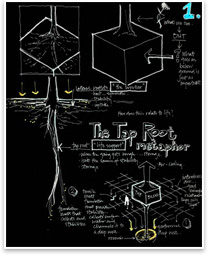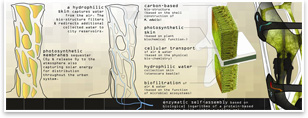
How do you . . . move beyond simple sustainability? Summary: HOK Architects, one of the largest design firms in the world, recently announced an alliance with the Biomimicry Guild, an innovation company that draws its inspiration from nature and biological processes. The goal of the alliance is to help HOK bring natural solutions to the built environment by integrating nature's innovations in the planning and design of buildings, communities, and cities worldwide. Learn more about the Biomimicry Guild from their Web site. Read about the Lavasa hill station community. See what the AIA National Committee on the Environment (COTE) knowledge community is up to. Do You Know SOLOSO? See what else SOLOSO has to offer for your practice.
Established by biologists Janine Benyus and Dr. Dayna Baumeister in 1998, biomimicry is a science that studies nature's best ideas and imitates these designs and processes to solve human problems. Biomimicry already has inspired numerous commercial products (the best known is probably Interface’s Entropy carpet tile) and individual building projects. The Biomimicry Guild’s alliance with HOK has the potential to expand dramatically the scale and impact of science into everyday life. The built environment is the most fertile ground for biomimicry, says Baumeister. “Buildings account for about 50 percent of total U.S. energy use, and our greatest collective impact will come from applying biomimicry to the planning and design of buildings, communities, and cities—at every scale and in every region,” she says. An unlikely alliance? “We have been familiar with the guild and Janine Benyus for many years, so this wasn’t a brilliant flash of ideas as much as something that evolved over time, a relationship that has matured, if you will, through exposure to Janine and her ideas and working with our organization,” adds Mary Ann Lazarus, sustainable design director, HOK. “HOK has been committed to a sustainable mission for 15 years as an early adopter. We recognized that our industry … has a real responsibility around the built environment, and we need to be looking for new kinds of solutions, ones that are going to be very different than what we’re used to in our fossil fuel based economy. We could see that by looking at natural systems, there might be new ideas that we can grasp and run with, so it was recognition on our part that this is important, and it’s something that as a firm we were committed to.”
“The guild members came to the site and did what they call a ‘genius’ of the place—that’s their terminology—to study the flora and fauna of that particular valley to understand how those systems deal with extreme conditions [of drought and monsoon],” recalls Lazarus. The Biomimicry Guild and HOK design team members met with the client at a series of charrettes to come up with bio-driven ideas to inform the design solutions. “The process is helping us define the kind of solution that’s different than what we’ve done in the past,” she says. "We believe biomimicry will not only help us significantly reduce the environmental impact of our projects, but also has the potential to help define a whole new sustainable standard for our profession,” concludes Lazarus. “Because biomimicry addresses critical environmental issues at the habitat scale, it gives us lessons on how to achieve significant results—even restorative outcomes—at all scales.”
|
||
Copyright 2008 The American Institute of Architects. All rights reserved. Home Page |
||
Photos
City of the Future rendering courtesy HOK and the Biomimicry Guild.
All other images courtesy of the Biomimicry Guild.


 Women
in Green: Voices in Sustainability
Women
in Green: Voices in Sustainability
